Artificial intelligence (AI) is taking industries by storm, yet only 16% of restaurant operators planned to invest in AI integration in 2024, according to the Technology Landscape report by the National Restaurant Association. Meanwhile, 76% of restaurant operators consider technology, including AI, being critical for outpacing their competitors.
To truly thrive and meet the expectations of today’s tech-savvy diners, restaurants can no longer afford to sideline AI. It’s the engine that lets them refine operations, tailor every guest’s visit, optimize pricing strategies, minimize waste, and more. This is why, in this article, we explore why implementing AI in restaurants is a critical business move, and how to do it effectively.
Artificial Intelligence in Restaurants: The Real Benefits
The use of artificial intelligence (AI) in restaurants can elevate several key aspects of the business, which will benefit not only the restaurant staff but also customers. Below, we list the most evident advantages of AI.
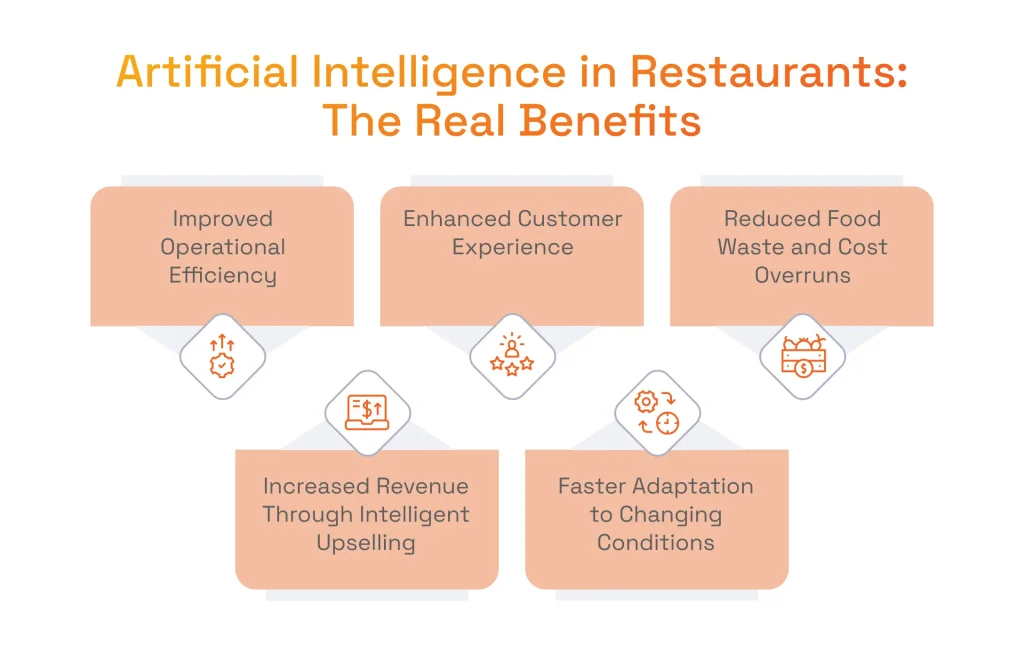
- Improved operational efficiency: AI streamlines restaurant operations by automating tasks, improving order accuracy, and preventing equipment failures. This results in faster service and smoother workflows.
- Enhanced customer experience: AI helps restaurants deliver faster, more personalized service by analyzing guest preferences, streamlining ordering, and reducing wait times. With AI, restaurants can create smoother, more satisfying dining experiences that keep customers coming back.
- Reduced food waste and cost overruns: AI for restaurant chains helps cut food waste, optimize inventory, and reduce costs by analyzing waste patterns and predicting demand.
- Increased revenue through intelligent upselling: AI for restaurants can boost revenue by analyzing customer orders in real time and recommending additional items that match their preferences.
Serhii Leleko
ML & AI Engineer at SPD Technology
“AI in restaurants enhances operations while preserving a personal touch. It’s not about replacing humans — it’s about bridging efficiency with individualized service.”
Where AI in Restaurants Is Already Making a Difference
There are multiple examples of the use of AI in the restaurant industry, where it drives actual results across different applications. If you’re wondering “How can a restaurant use AI?”, here are some of the most common and impactful use cases to consider.
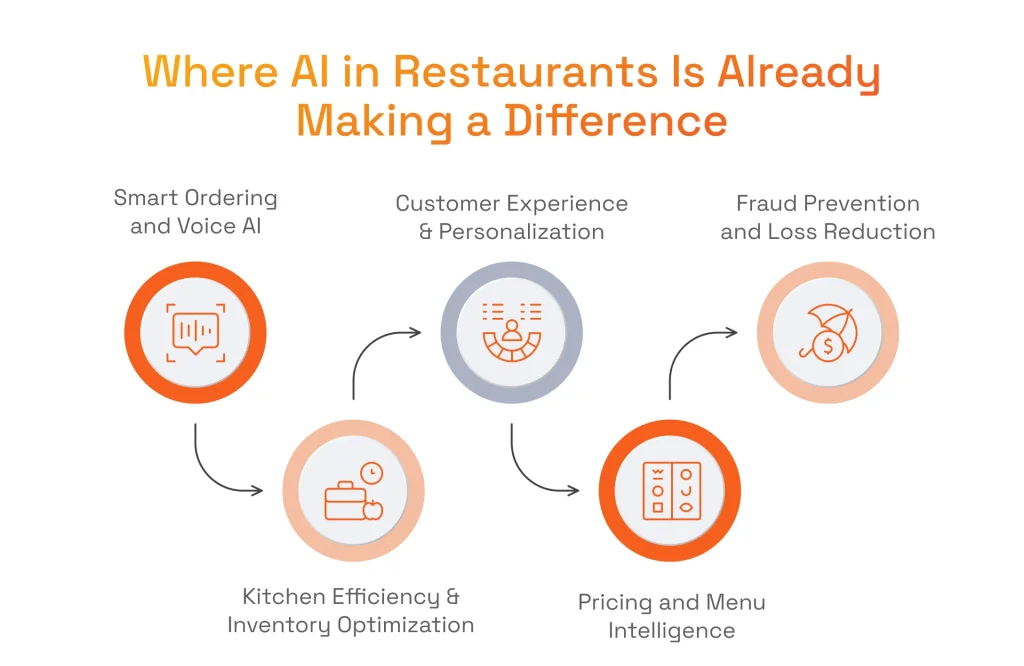
Smart Ordering and Voice AI
Many fast-food chains are installing AI-powered ordering systems at drive-thrus, where voice assistants take orders faster, built-in smart upselling mechanisms analyze preferences to suggest additional menu options, and overall automation enhances the customer experience and boosts sales.
One of the notable examples of this benefit is Wendy’s that uses AI-powered drive-thru technology to cut wait times by 22 seconds, improving speed and convenience for every guest. McDonald’s is also upgrading 43,000 locations with AI-powered drive-thrus and smart kitchen tools to cut wait times and boost accuracy, aiming to grow its customer base to 250 million by 2027. Carl’s Jr, in turn, uses AI in its drive-thru systems to take orders and suggest complementary items, ensuring average check size increases without feeling pushy.
Kitchen Efficiency & Inventory Optimization
A whole new level of kitchen efficiency can be achieved with artificial intelligence in the restaurant industry. It can be done through forecasting that helps restaurants prepare the right amount of food at the right time, smart scheduling that aligns staffing with demand, and AI-powered sensors that monitor freshness and stock levels in real time.
One of the notable examples of AI-driven demand forecasting is shown by Domino’s Pizza. The largest pizza company teamed up with Microsoft to create an AI-powered demand planning that helps manage pizza orders and resources. It was reported that the company saw a 72% improvement in accuracy using the demand planning in 2023. Meanwhile, IKEA UK&IE uses AI-powered scales and cameras to track food waste, cutting it by 37% and saving £1.4 million.
Customer Experience & Personalization
Leveraging AI for restaurant chains allows for highly personalized guest experiences. Businesses can use AI chatbots to take orders, handle reservations, answer FAQs, and send follow-ups. Food companies can go even further and use AI algorithms to analyze behavior patterns, including order history, visit frequency, and preferences, to further optimize offerings or tailor loyalty programs and promotions to individual customers.
To elevate individual dining journeys, Applebee’s and IHOP are set to integrate an AI-powered “personalization engine.” This system will provide AI restaurant recommendations, like new or complementary menu items, intelligently tailored to each customer’s past purchases and the preferences of diners with similar tastes.
AI restaurant applications can have tools for analyzing real-time data on demand, ingredient costs, and customer behavior. Thus, restaurants can set up dynamic pricing that adjusts item prices based on factors like time of day or popularity, maximizing revenue, and approach the menu smartly by identifying best-selling and underperforming items. AI also tailors menus by location, aligning offerings with local preferences and purchasing patterns.
Applebee’s and Outback Steakhouse are prominent examples of using AI for adjusting menu offerings and pricing dynamically. These chains report that they achieved increased check sizes and table turnover thanks to AI. They also note that the technology assists them in tailoring promotions by analyzing sales data, peak times, and customer preferences in real time.
AI for Restaurants in Fraud Prevention and Loss Reduction
Restaurants using AI in POS systems can safeguard transactions and monitor data to spot anomalies. These systems flag unusual movement patterns and unconventional employee activity, which allows restaurants to have proactive intervention measures to reduce theft.
To achieve this level of security, companies can combine POS development services with AI/ML integrations. Custom AI algorithms can be tailored to detect fraud-specific patterns based on the restaurant’s unique operational data. In this manner restaurants gain real-time visibility and automated alerts, which boosts fraud detection.
The impact of AI on food is vast. Continue reading to empower your understanding of the role of AI in the food industry.
AI and Restaurants: New and Emerging Innovations
The use of AI and machine learning development services in the restaurant industry is still in its early stages, but it already offers impressive examples of operational improvement, and there’s much more to come.
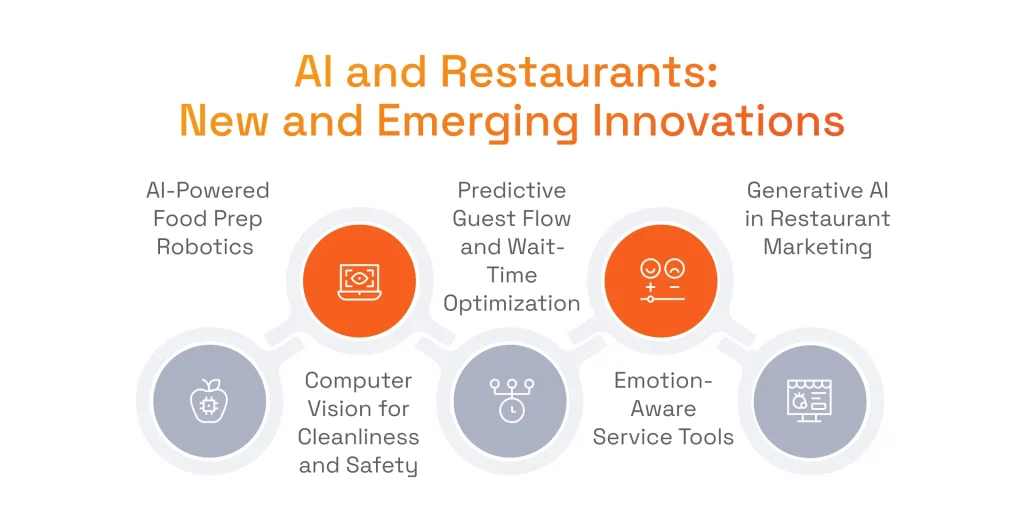
- AI-powered food prep robotics: AI used in the restaurant industry can be leveraged for kitchen robotics to redefine food preparation by automating complex cooking tasks with speed and precision. In Dubai, a newly launched restaurant features an AI chef that independently prepares and cooks over 200 international dishes without human intervention. The restaurant owner highlights that this system improves consistency, reduces labor strain, and maintains hygiene standards.
- Computer vision for quality control, cleanliness, and safety: AI and computer vision development can be used together to create systems with real-time monitoring. In terms of quality control, it can ensure proper food presentation. Domino’s had similar initiatives with DOM Pizza Checker to visually inspect every pizza, verifying toppings and presentation for consistency. The similar restaurant technology can be also leveraged for checking the kitchens and dine areas for safety issues (slippery floors, obstructed emergency exits, etc.) or cleanliness standards (monitoring spills, unclean surfaces, overflowing trash bins, etc.)
- Predictive guest flow and wait-time optimization: Restaurants can leverage data analytics services to equip their AI systems with accurate forecasts of guest flow. While data analytics uncovers these patterns and insights from historical restaurant industry data, weather patterns, time of day, and local events, the restaurant AI uses them to make real-time decisions, such as adjusting staffing levels, optimizing kitchen prep, or communicating precise wait times to guests. This predictive power enables restaurants to staff more efficiently, prepare in advance for busy periods, and communicate accurate wait times to guests.
- Emotion-aware service tools: Custom AI solutions for restaurants are emerging that can interpret customer tone, facial expressions, or written feedback to assess mood and sentiment. These systems assist restaurants in expanding use of AI to take orders with more empathy to frustrated guests or upselling to satisfied ones. As a result, restaurants make service interactions feel more attentive and human, which contributes to boosted customer experiences.
- Generative AI in marketing: Restaurant marketing teams can benefit from using generative AI tools to quickly produce daily specials, promotional emails, and engaging social media posts. This use of AI in restaurants ensures a consistent brand voice and accurately addresses customer preferences. At the same time, it assists in automating time-consuming creative tasks, which frees up marketing teams while keeping the restaurant’s online presence fresh and relevant to its audience.
Serhii Leleko
ML & AI Engineer at SPD Technology
“When applying computer vision for optimizing kitchens, predictive models for forecasting demand and gen AI for shaping marketing, we’re only scratching the surface. The future points to autonomous kitchens, adaptive menus, and individualized guest experiences powered by AI-driven systems.”
5 Reasons Forward-Thinking Restaurants Are Adopting AI Now
Using AI for restaurants drives tangible results across business operations. Restaurant owners can leverage it to tackle challenges related to staffing, rising costs, customer expectations, and competitive pressure. A closer look at each area follows.
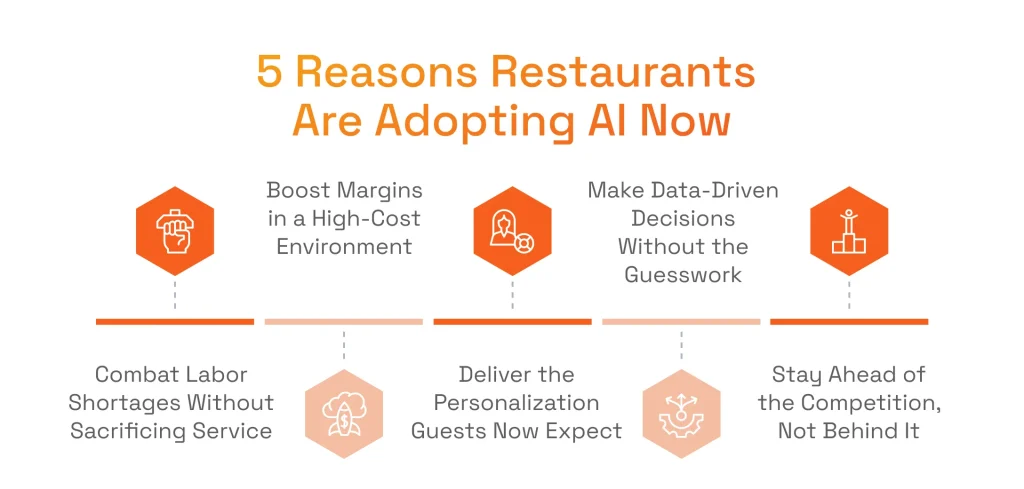
Combat Labor Shortages Without Sacrificing Service
Utilizing artificial intelligence in restaurants can reduce the impact of labor shortages. The technology automates routine tasks, including order-taking, inventory management, and staff scheduling, which allows staff to do more tasks in the same or even shorter period of time. What’s more, AI can be integrated in self-service kiosks, AI chatbots, and robotic kitchen assistants for reducing the pressure on teams while preserving service quality and speed. Thus, restaurants can maintain high-quality service even when understaffed.
Boost Margins in a High-Cost Environment
Rising food, labor, and utility costs are squeezing restaurant margins, but there is a path to profitability with AI for restaurant businesses and its demand forecasting. With it, restaurants can align purchasing with actual sales trends. Further, AI enables dynamic pricing that makes menu prices easily adjustable in real-time based on demand, cost fluctuations, or the time of day. Not only do these AI-driven practices help avoid overspending, but they also reduce waste, making businesses more sustainable.
Deliver the Personalization Guests Now Expect
Today’s diners expect tailored experiences. By using AI in the restaurant industry, personalization can be scalable and diverse with suggested menu items based on past orders to customizing promotions, loyalty rewards, adjustable portion sizes or meal combos, highlighted allergen-free or vegan options, and more. AI does it by learning from customer data and feeding it into recommendation engines. As a result, restaurants deliver relevant offers and drive higher satisfaction, increased repeat visits, and more revenue per customer.
Make Data-Driven Decisions Without the Guesswork
With AI, restaurants can turn raw data into actionable insights. In this way, data on sales, peak traffic times, underperforming locations, pricing, inventory, and other business aspects become a tool for adjusting operations and making smarter decisions. Taking all this data into account, restaurant artificial intelligence gives way to more nuanced, strategic planning. Consequently, restaurants can stay agile and proactive for ensuring profitable margins.
Stay Ahead of the Competition, Not Behind It
Early adopters of artificial intelligence in restaurants are gaining a competitive edge by running leaner operations, delighting customers, and innovating faster. AI helps restaurants spot trends before they go mainstream, test menu changes efficiently, and scale winning strategies across locations. It also improves agility, which is essential in a market disrupted by delivery apps, ghost kitchens, and evolving consumer preferences.
Artificial Intelligence (AI) in Restaurants: Common Myths
When it comes to the implementation of artificial intelligence in the restaurant industry, our clients often note some concerns about this new technology. While some of the potential issues are 100% valid, others turn out to be common misconceptions. Below we address them.
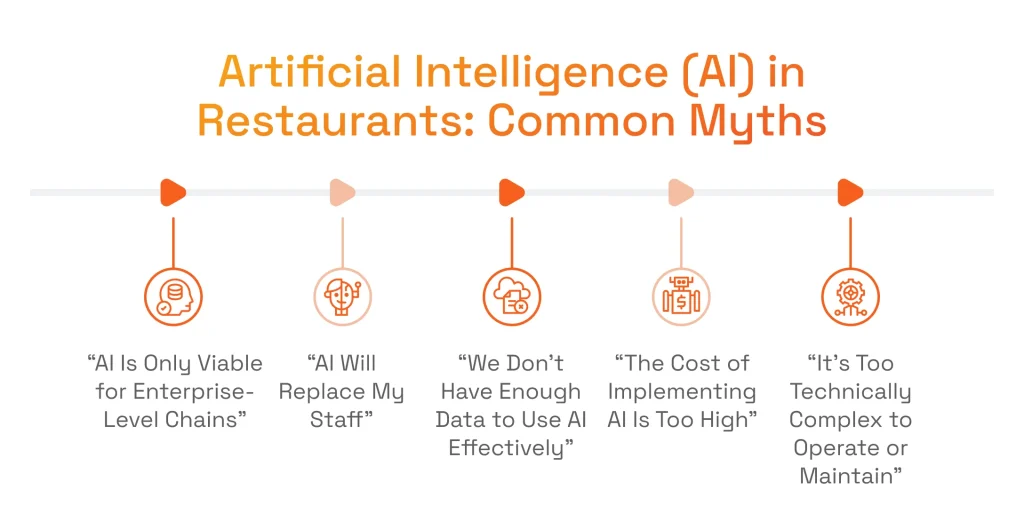
Myth 1: “AI Is Only Viable for Enterprise-Level Chains”
AI is no longer reserved for massive franchises with deep pockets like McDonalds or Domino’s. Many modern AI solutions are specifically designed for small to mid-sized restaurant operators: these solutions are cloud-based, have modular features, pay-as-you-go pricing, and minimal setup requirements. Most restaurant technology providers help to install those ready-made solutions or ship pre-trained models and plug-ins for the POS restaurants already use.
Myth 2: “AI Will Replace My Staff”
Artificial intelligence and machine learning in the restaurant industry aim to support human workers, not replace them. It off-loads repetitive or time-consuming tasks like inventory tracking, order-taking, and forecasting, so the restaurant team can focus on tasks bots can’t replicate, such as ensuring hospitality and excellent customer service. When used properly, AI helps restaurant employees with productivity, reduces burnout, and enhances job satisfaction by freeing staff from operational overload.
Myth 3: “We Don’t Have Enough Data to Use AI Effectively”
Typically, restaurants have more data than they realize. Common tools like POS systems, online ordering platforms, loyalty programs, and employee schedulers already generate rich datasets that can be used for training AI. On top of that, data from marketing channels like social media and feedback platforms can add data to AI. With all these sources available, AI tools can easily deliver insights even for a newly opened restaurant after just a few weeks of operating.
Myth 4: “The Cost of Implementing AI Is Too High”
Today, modular subscriptions replace six-figure installs. Thanks to SaaS-based pricing, cloud platforms, and open-source tools, AI adoption is more affordable than ever. Restaurants don’t need a massive upfront investment or internal tech team. Better yet, businesses can expect ROI within the first months after adoption as AI helps reduce food waste, labor costs, and missed revenue opportunities.
Myth 5: “It’s Too Technically Complex to Operate or Maintain”
The evolution of AI and restaurants has led to platforms engineered for ultimate user-friendliness. Restaurants can forget complex tech as today’s solutions boast intuitive dashboards, perfect integrations with POS and kitchen systems, and proactive support. The team can quickly adopt these tools with minimal training, as vendors take care of all the setup and deliver constant updates.
Signs You Are Ready to Implement AI for Restaurant
If you are not sure whether your restaurant business can benefit from AI, there are clear signs that can suggest that.
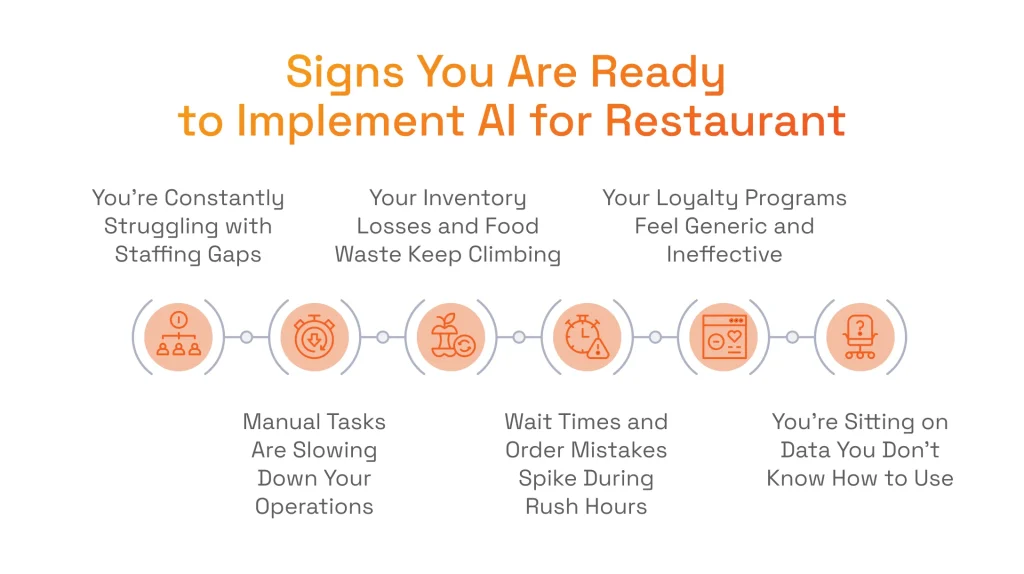
- You’re Constantly Struggling with Staffing Gaps: Open shifts, excessive overtime, and burnout indicate your scheduling tools can’t keep up.
- Manual Tasks Are Slowing Down Your Operations: If managers still compile prep lists, reconcile invoices, or tally timesheets by hand, you’re leaking hours that could be spent on service.
- Your Inventory Losses and Food Waste Keep Climbing: Increasing shrinkage and spoilage show you’re guessing at your target stock levels and reorder schedules.
- Wait Times and Order Mistakes Spike During Rush Hours: Bottlenecks at the counter or kitchen point to workflow inefficiencies.
- Your Loyalty Programs Feel Generic and Ineffective: Low redemption rates suggest one-size-fits-all rewards.
- You’re Sitting on Data You Don’t Know How to Use: POS, delivery apps, and staff schedulers generate thousands of data points daily, but reports sit untouched, and insights go unrealized.
At the same time, recognizing the need for smarter restaurant systems is one thing, and knowing where to start is another entirely. That’s the critical point where the right tech partner makes all the difference. Here, at SPD Technology, we have a proven track record of guiding diverse restaurants in deploying AI-driven solutions that are easy to adopt, measurably increase profits, and significantly improve guest satisfaction.
We make AI adoption for restaurants as easy as possible. You can choose our dedicated development team if you’re looking for a complete, hands-off approach. Our experts will handle every aspect of your AI solution, from initial concept and custom development to seamless integration and ongoing support.
Alternatively, if you have an in-house tech team, our staff augmentation service can provide the specialized AI expertise you need. We’ll embed our skilled AI developers directly into your team, working alongside them to accelerate your projects, share knowledge, and fill any skill gaps.
Our teams comprise AI specialists, data scientists, and industry experts who understand the unique challenges and opportunities restaurants face. This specialized knowledge means we speak your language, grasp your operational nuances, and can swiftly identify how AI can genuinely transform your business, from optimizing inventory and predicting demand to personalizing guest experiences and streamlining back-of-house operations.
Conclusion
Artificial intelligence (AI) in restaurants is set to reinvent how businesses operate. It can ensure operational efficiency, enhanced customer experiences, reduced food waste, lowered costs, increased revenues, and faster adaptability. These benefits are already experienced by such huge chains as McDonald’s, Wendy’s, Domino’s and IKEA through AI-driven voice assistants in drive-thrus, smart kitchens, AI chatbots, dynamic pricing, personalized menus, and advanced fraud detection. But these are just scratching the surface, as AI in restaurants can go further with food prep robotics, computer vision for quality and safety control, predictive guest flow, emotion-aware service and genAI-based marketing.
If businesses see that they need to combat labor shortages, improve margins, deliver personalization, make informed decisions, and overcome competition, then they must adopt AI as soon as possible. The partnership with a seasoned tech vendor can help with that. We also helped restaurants to leverage AI and cover staffing gaps, reduce manual tasks, cut waste, and set up personalized loyalty programs. If you also need our help, just reach out to us, and we will come up with the solution for your unique needs.
FAQs
What Is the ROI of Implementing AI in Restaurants?
Return on investment for restaurant AI is measured in months, not years. For example, a study by the University of Exeter shows that food waste systems like Winnow Vision cut waste by up to 50% and trim food costs 3–8%, generating payback inside twelve months in 95% of deployments.
What Are the Ethical Concerns of Using AI in Food Services?
AI in food service raises privacy, bias, and labor questions. Here are some of them:
- Customer-facing algorithms collect personal data, making stringent cybersecurity and transparent consent essential.
- Training data can embed racial or socioeconomic bias, skewing pricing or table allocation.
- Automation may displace some roles.
- AI’s carbon footprint must be minimized through green hosting and efficiency measures.
Is Implementing AI Technology Affordable for a Small or Independent Restaurant?
Yes. Most vendors offer software-as-a-service plans, with seat-based rates as low as US $19 per user per month. Furthermore, cloud hosting, automatic updates, and pre-built integrations remove capital expenditure that allows for a confident artificial intelligence and restaurants integration.

